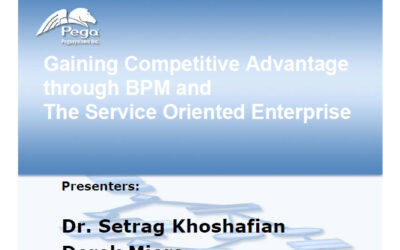The Logistics Management Division for NASA includes the Wallops Island Facility, Goddard Space Flight Center, and NASA Headquarters. It has four branches, 50 civilian servants, and 225 contractor personnel. The division has 12,000 Civil Service and contractor personnel. The flight project support operations are ISO 9001 certified, with the processes fully documented. For the institutional support services, the processes are documented in Standard Operating Procedures (SOPs). The goal was to be certified by August, 1999.
Articles by: BPMInstitute.org
Gaining Competitive Advantage through BPM and The Service Oriented Enterprise
The Service Oriented Enterprise is a new approach in business. Each party or participant in service orientation sees themselves as a service provider and consumer, in an increasingly well connected global economy. This is not new: businesses have been serving their clientele since time immemorial. But service orientation is different in two essential ways. First, culturally organizations are realizing the best productivity could be achieved if they focus on serving the needs of their customers but also their employees, trading partners, shareholders, government, and communities.
The Changing Face of FBI IT
The mission for the FBI has evolved dramatically since 9/11. The FBI is transforming its IT systems to support counterterrorism, intelligence, law enforcement, and administrative missions. BPM is vital to the FBI’s continued transformation and evolution and provides the FBI with a cross-functional view of processes.
Web 2.0 and Brokered Web Services
Web services were created around the notion that it’s easier to discover and leverage somebody else’s service, rather than write your own from scratch. Also, it is much easier to create applications made up of many services, allowing change to occur at a pace faster than anything we’ve seen in the industry thus far.
The idea of Web services was to create a standard interface, programming model, description language, and a directory which would allow this to happen in and between very different systems.
Case Study: Enterprise-Wide Performance and Business Process Management of Government: Setting the Global Agenda for the Next 10 Years and Beyond
The Florida Department of Revenue has over 5000 employees and a $400M budget. It is the sixth largest agency in the state. The total taxes collected are over $35B for the fiscal year.
The goal of the Department of Revenue’s strategic initiative is to become competitive with world-class organizations in its results and be able to accomplish the mission better than anyone else could. The customers, stakeholders, beneficiaries and suppliers (tax payers) are:
- Policymakers (the Legislature)
- Federal Government
Selecting a BPMS
Dr. Bruce Silver is an independent industry analyst and consultant focused on business process management and content management technologies. He is the author of the 2006 BPMS Report series, evaluations of leading BPMS offerings available free through...
The FBI Launches a Major Business Process Reengineering Effort
Robert J. Garrity Jr., a 29-year veteran of the Federal Bureau of Investigation, is no stranger to solving intricate information infrastructure issues.
When You Say “Process,” You Mean…?
Inside organizations that are doing various kinds of process “work”-whether improvement projects, technology enhancements or process definition and documentation—we often hear a lot of confusion and frustration because people sometimes mean different things when they use the word “process.” The most common frustration happens when two people are talking at different “levels” of process—with one person perhaps talking about a big end-to-end process such as order fulfillment while the other person is talking about a single task but one with multiple steps and considerable complexity—yet both are
BPMS Watch: What BPMS Can Learn from Business Rule Management
One of the core promises of BPMS is that it lets process owners on the business side model, monitor, and maintain their own process implementations. While chronically backlogged IT is hypersensitive to the charge that they take too long to respond to the changing demands of business, it still resists ceding to the business the power to maintain business process solutions themselves, much less build them from scratch. In fact, for many architects and developers the mere suggestion of business-driven implementation taints the whole BPMS concept.
Who, What and How of a Business Rules Analyst
In my first article, I emphasized the vitality of the role of an IT Business Analyst and how it is expanding due to business demands for high performance. Business Analysts identify the business needs of their clients and stakeholders to help determine solutions to business problems. They play a vital role throughout the project life cycle by understanding and representing stakeholder needs, documenting and organizing the requirements for a system, and communicating requirements to an entire team.

















